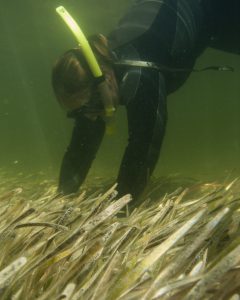Assessing the condition of seagrass, sea urchins, and scallops
 The UF/IFAS Extension Agent and a certified scientific volunteer diver visited the area between Piney Point and Grassy Island to assess the condition of seagrass, sea urchins (https://myfwc.com/research/saltwater/codes/food-bait-invertebrates/variable-urchin/) and scallops following the concern of local boaters. To compare the survey results, the team visited 2 sampling stations defined by the Big Bend Seagrass Aquatic Preserve or BBSGAP (SMAR25, coordinates N 30.07035 W -84.07165, and SMAR22, coordinates N 30.05926 W -84.05395), which they monitor on a regular basis. Using 50 meters transect and a 0.25 m2 quadrat we collected data on sediment type, total seagrass coverage and composition, epibiota density, seagrass blades height, and urchin and scallop density (count) every 10 meters.
The UF/IFAS Extension Agent and a certified scientific volunteer diver visited the area between Piney Point and Grassy Island to assess the condition of seagrass, sea urchins (https://myfwc.com/research/saltwater/codes/food-bait-invertebrates/variable-urchin/) and scallops following the concern of local boaters. To compare the survey results, the team visited 2 sampling stations defined by the Big Bend Seagrass Aquatic Preserve or BBSGAP (SMAR25, coordinates N 30.07035 W -84.07165, and SMAR22, coordinates N 30.05926 W -84.05395), which they monitor on a regular basis. Using 50 meters transect and a 0.25 m2 quadrat we collected data on sediment type, total seagrass coverage and composition, epibiota density, seagrass blades height, and urchin and scallop density (count) every 10 meters.
Survey
 The survey determined a Braun-Blanquet (B&B) density value of seagrass of 2.0, with sediment type mainly composed by sand/shell, gravel, fine sand/mud. The average of total seagrass coverage was 5-10%, with only one with 0-5% and one with 10-15% coverage. Predominant seagrass species was Turtle grass (Thalassia testudinum), and some presence of Manatee grass (Syringodium filiforme). Epibiota (organisms growing on seagrass blades) was none too low on most of the samples. Blade’s height was 8 to 14 cm for Turtle grass and 10 to14 cm for Manatee grass. Sea urchin counts averaged 13.3 urchins/m2 for the two sampling sites. With a minimum of 4 urchin/m2 to a maximum of 20 urchin/m2. No scallops were counted during the survey.
The survey determined a Braun-Blanquet (B&B) density value of seagrass of 2.0, with sediment type mainly composed by sand/shell, gravel, fine sand/mud. The average of total seagrass coverage was 5-10%, with only one with 0-5% and one with 10-15% coverage. Predominant seagrass species was Turtle grass (Thalassia testudinum), and some presence of Manatee grass (Syringodium filiforme). Epibiota (organisms growing on seagrass blades) was none too low on most of the samples. Blade’s height was 8 to 14 cm for Turtle grass and 10 to14 cm for Manatee grass. Sea urchin counts averaged 13.3 urchins/m2 for the two sampling sites. With a minimum of 4 urchin/m2 to a maximum of 20 urchin/m2. No scallops were counted during the survey.
Previous reports by the BBSGAP (https://floridadep.gov/rcp/aquatic-preserve/locations/big-bend-seagrasses-aquatic-preserve) indicated an average total grass of 4.5 in the B&B scale (50-75% coverage) for the area while the current survey findings are a 2.0 in the B&B scale (5-25% coverage), which means a reduction of 2.5 points in the B&B scale or a decrease between 75% and 60% of seagrass coverage. Sea urchins counts in the Steinhatchee area ranged from 5 to 60 urchins/m2 between 2018 and 2020. Reports from the FWRI (Florida Wildlife Research Institute) in previous years found more sampling stations with no scallops and more stations with high densities. This means that scallops are distributed in patches.
Survey Conclusion
The survey concludes there is an evident decrease of about 70% on seagrass coverage of an area estimated at about 3 nm2. Causes of the decrease in coverage might be attributed possibly to cold weather and the high abundance of sea urchins grazing on seagrass.
Also, that seagrass roots (rhizomes) seem to be in good conditions, and after a dormant period during Fall and Spring, they start re-growing and reach normal coverage levels.
Third, sea urchin abundance increased possibly due to an important cohort recruitment which will likely be reduced over time.
Fourth, the surveyed area, which is regularly used by boater as scallop harvesting grounds, show a high reduction in scallop. This might possibly be because scallops are seagrass-dependent, and the reduction of seagrass coverage exposed scallops to natural predation.
Finally, previous years have reported a patch-like distribution of scallops so boaters might need to find suitable seagrass areas to harvest scallops during the open season.
 0
0
